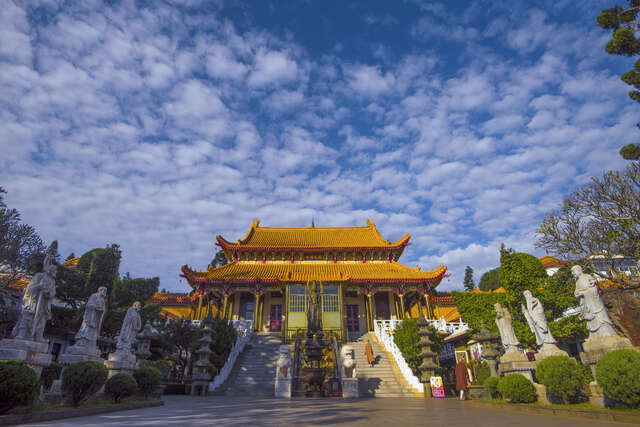Yuan Guang Temple Introduction
Yuan Guang Zen Temple's overall plan adheres to the traditional regulations of a monastery. Surrounded by elegant green tiles and white walls, the solemn and grand northern palace-style architecture, along with the exquisite garden design, forms a breathtaking landscape reminiscent of a paradise on Earth. A statue of a spotted deer perched on the Dharma Wheel at the side gate symbolizes the Buddha's initial teaching of the Four Noble Truths to the five ascetics in Deer Park, reflecting the abbot's aspiration to revive monastic education. Inside the mountain gate is the Maitreya Hall, dedicated to the laughing Maitreya, modeled after the cloth-bag monk, and the bodhisattva Weituo, who vows to protect the Dharma. On either side stand the Four Heavenly Kings, carved in lifelike detail. The joyfully laughing Maitreya Bodhisattva brings happiness to every visitor, while the Weituo Bodhisattva holds a precious sword, exuding a formidable presence that intimidates demonic forces. Upon entering through the mountain gate, one finds a spacious plaza flanked by gardens filled with flowers and greenery. Continuing forward leads to the grand hall, with stone steps dividing into two sides. In the center is a statue of nine dragons spiraling, with Avalokiteshvara Bodhisattva standing atop the dragons, holding a pure vessel to guide sentient beings. The Mahavira Hall stands at the center of the entire temple compound, serving as a spiritual fortress for the disciples. Inside the hall, the Three Holy Ones of Huayan are enshrined: Shakyamuni Buddha, Manjushri, and Samantabhadra, with Kasyapa and Ananda on either side. Below the hall is the Dharma Hall, usually used for women's morning and evening services, while on holidays, it serves as a space for lay practitioners. The rear hall, the Merit Hall, enshrines Ksitigarbha Bodhisattva and the revered Mu Jian Lian, where worshippers can place ancestral tablets. Additionally, there are a dining hall, five contemplative halls, classrooms, and dormitories, accommodating over a hundred people. (Source: Yuan Guang Zen Temple)








































